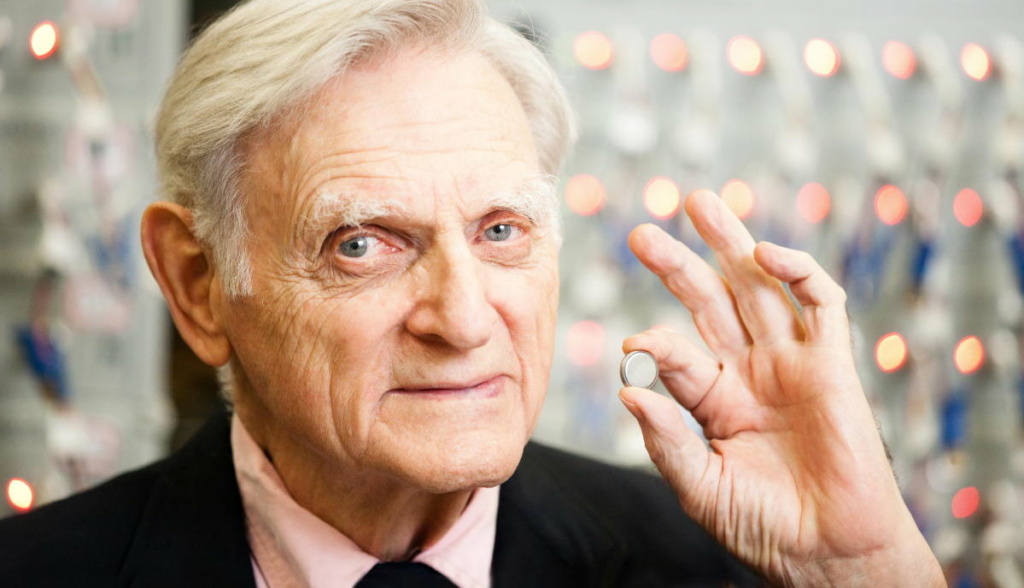
Battery pioneer and oldest Nobel laureate ever John Goodenough dies
Even winning a Nobel Prize in 2019, when he was 97, couldn’t convince John Goodenough to stop tinkering with battery chemistry. Still in the lab until well into his nineties, he never lost hope that he could match or even top the breakthrough he achieved at age 57 – not content with an incremental step, he was looking for a revolutionary improvement. It wasn’t to be. John Bannister Goodenough died on 25 June, aged 100.
In terms of societal impact, the invention of the lithium-ion battery ranks up there with the transistor. The latter gave us computing power, the former enabled us to put that power in our back pockets. Just imagine what the world – and indeed the semiconductor, communication and electronics industries – would look like without the compact but energy-dense battery packs we take for granted today.
And yet, it took the Nobel committee a long time to recognize the importance of the lithium-ion battery. The inventors of the transistor were awarded the world’s highest scientific honor in 1956, less than a decade after the birth of the electronic switch. The originators of the lithium-ion battery – Goodenough shared the Nobel Prize in Chemistry with Stanley Whittingham and Akira Yoshino – had to wait forty years for their achievements to be recognized.
Inroads
Goodenough’s crucial contribution to the lithium-ion battery was the cobalt-oxide cathode. Having moved from MIT to Oxford University in 1976, Goodenough learned of Exxon-employed Whittingham’s successful efforts to reversibly store lithium ions in titanium sulfide (TiS2), opening the door to a rechargeable battery. As a cathode, however, TiS2 disappointed. Upon charging, spikes grew out of the metallic lithium anode, eventually short-circuiting the battery.
Goodenough had a hunch that certain lithiated metal oxides (LiMO2) would do better. He had two postdoctoral researchers methodically screen metal oxides for the ability to take in and let go of lithium ions. They found that they could extract about half of the lithium ions before the layered host materials collapsed. Importantly, they could do so at a significantly higher voltage than most known battery systems at the time, meaning they would be able to store much more energy. Ultimately, this is what enabled portable devices, which depend on small, lightweight batteries that can pack enough charge.
Of all tested metals, cobalt proved the best and most stable. Paired with the graphite anode developed by Akira Yoshino, this became the de facto standard combination. Sony was the first to commercialize the configuration in 1991, prompting a frenzy among competitors to copy the design that left all other charge-storing technologies, such as nickel-cadmium, in the dust. These days, often mixed oxides of nickel and cobalt are used to prolong lifespan.
Goodenough also came up with two more cathode materials that were eventually commercialized. Lithium iron phosphate (LFP) and lithium manganese oxide batteries are safer and last longer, at the expense of a lower energy density. They’re found in power tools and medical wearables, among other things, but they’re also making inroads in electric vehicles and grid-storage solutions.
Reward enough
For all their potential, Goodenough barely saw a dime for his discoveries. The University of Oxford wasn’t interested in intellectual property at the time and the atomic energy organization he was collaborating with required him and his colleagues to sign away all royalty claims. “Not knowing either the full potential of our invention or any other option,” they did, Goodenough wrote in a scientific autobiography published on the Nobel Prize website.
For LFP, a Japanese student quietly shared a breakthrough in Goodenough’s lab with his sponsor, the Nippon Telegraphy and Telephone company, which went on to develop the technology in secret. Later, US company A123 claimed to have developed a sufficiently different type of iron phosphate battery to escape Goodenough’s patent. The University of Texas, where Goodenough had moved to just before he would have been forced to retire at Oxford because of his age, took the disputes to court. The NTT case was settled without an admission of guilt, but, despite a huge IPO in 2008, A123 never paid anything.
It never bothered Goodenough. “The joy of having helped enable a technology that has transformed for the better so many lives is reward enough,” he wrote.
Main picture credit: University of Texas






